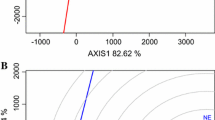Abstract
Hexaploid triticale has many advantages over both parental species for both grain and forage production in certain environments. Additional information on environmental stability and heritability would be desirable to develop appropriate selection strategies in the production of superior widely-adapted cultivars. The grain yield of 22 diverse genotypes grown at four ecologically-distinct geographical locations [Quincy, FL, USA (approximate geographical coordinates (AGC) = 30°N 84°W, approximate elevation (AE) = 58 m), Plains, GA, USA (AGC = 32°N 84°W, AE = 76 m), Bozeman, MT USA (AGC = 45°N 111°W, AE = 1458 m), and Aberdeen, ID, USA (AGC = 42°N 112°W, AE = 1360 m)] was measured in two years with winter and spring planting dates only at Bozeman and Aberdeen. Test weight (grain weight in a given volume) was determined for two years at Bozeman and Aberdeen at both planting dates and one year at Quincy. Stability analyses indicated that significant (P < 0.01) variation in means, regression coefficients, and deviation mean squares of the genotypes were present for both characters. Realized heritability (h 2) estimates were as follows: grain yield ranged from −0.02 to 0.80 with a mean of 0.57; test weight ranged from 0.63 to 1.05 with a mean of 0.93. The results indicated that substantial genetic variation is present and selection for widely-adapted cultivars would be effective for both characters especially test weight.
Similar content being viewed by others
References
Becker HC, Leon J, 1988. Stability analyses in plant breeding. Plant Breeding 101: 1–23.
Doolittle DP, 1987. Realized heritability. In: Bresler E, Thomas GW, Van Vleck LD, eds. Population Genetics: Basic Principles. Adv Series Agric Sci Vol 16. Berlin, Springer-Verlag: 187–191.
Eberhart SA, Russell WA, 1966. Stability parameters for comparing varieties. Crop Sci 6: 36–40.
Finlay KW, Wikinson GN, 1963. The analysis of adaptation in a plant-breeding programme. Aust J Agr Res 14: 742–754.
Furman BJ, Qualset CO, Skovmand B, Heaton JH, Corke H, Wesenberg, DM, 1997. Characterization and analysis of North American triticale genetic resources. Crop Sci 37: 1951–1959.
Gupta PK, Priyadarshan PM, 1982. Triticale: Present status and future prospects. Adv. Genet 21: 255–345.
Harter HL, 1960. Critical values for Duncans new multiple range test. Biometrics 16: 671–685.
Juskiw PE, Helm JH, Salmon DF, 2000a. Competitive ability in mixtures of small grain cereals. Crop Sci 40: 159–164.
Juskiw PE, Helm JH, Salmon DF, 2000b. Forage yield and quality for monocrop and mixtures of small grain cereals. Crop Sci 40: 138–147.
Oettler G, 1996. Variation and covariation of agronomic traits and quality in triticale at low nitrogen input. Plant Breeding 115: 445–450.
Pfahler PL, 1971. Heritability estimates for grain yield in oats (Avena sp.). Crop Sci 11: 378–381.
Pfeiffer WH, 1996. Triticale: Potential and research status of a man-made cereal crop. In: Guedes-Pinto H, Darvey N, Carnide VP, eds. Triticale: Today and Tomorrow. Dordrecht, Kluwer Acad Publ: 571–580.
Qualset CO, Furman BJ, Heaton JH, Skovmand B, Wesenberg DM, 1996. Assembly and analysis of a North American Triticale Genetic Resources Collection. In: Guedes-Pinto H, Darvey N, Carnide VP, eds. Triticale: Today and Tomorrow. Dordrecht, Kluwer Acad Publ: 261–267.
Rao SC, Coleman SW, Volesky JD, 2000. Yield and quality of wheat, triticale, and Elytricum forage in the southern plains. Crop Sci 40: 1308–1312.
Royo C, Soler C, Romagosa I, 1995. Agronomical and morphological differentiation among winter and spring tricales. Plant Breeding 114: 413–416.
Schegel R, 1996: Triticale - Today and tomorrow. In: Guedes-Pinto H, Darvey N, Carnide VP, eds. Triticale: Today and Tomorrow. Dordrecht, Kluwer Acad Publ: 21–31.
Sun YS, Vie Y, Wang ZY, Hai L, Chen XZ, 1996. Triticale as forage in China. In: Guedes-Pinto H, Darvey N, Carnide VP, eds. Triticale: Today and Tomorrow. Dordrecht, Kluwer Acad Publ: 879–886.
Author information
Authors and Affiliations
Corresponding author
Rights and permissions
About this article
Cite this article
Barnett, R.D., Blount, A.R., Pfahler, P.L. et al. Environmental stability and heritability estimates for grain yield and test weight in triticale. J Appl Genet 47, 207–213 (2006). https://doi.org/10.1007/BF03194625
Received:
Accepted:
Issue Date:
DOI: https://doi.org/10.1007/BF03194625




